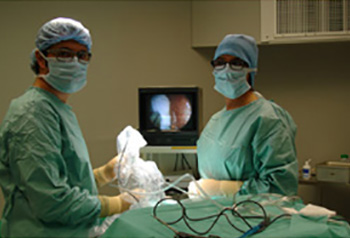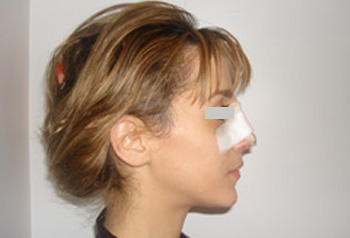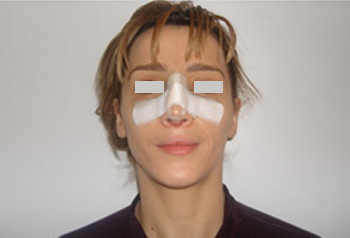THE SURGICAL INTERVENTION
Once in his room, he will have an antiseptic shower; he will then be taken to the operating theatre suite.

SURGERY
Function-oriented treatments, if necessary, are carried out at the beginning of the operation:
- reduction of the lower turbinate bones: in case of hypertrophy (chronic, allergic or vasomotor rhinitis) thanks to bipolar cauterization.
- septoplasty: operation enabling to straighten the curvature of a nasal septum leading to nasal obstruction or nose distortion.
- surgery of the sinuses: in case of a chronic sinusitis revealed by the pre-operative scan.
Rhinoplasty can start!
DECONSTRUCTION
Liberation of the cartilages of the point(headland). Separation of the triangular cartilages of the dorsum. Grating of so necessary bones (manual or motorized). Separation and mobilization of bones by specific ostéotomies for every patient. ( Manual or motorized Technique) then control of the alignment of the dorsum, its width and its height.
RECONSTRUCTION
The triangular cartilages are stitched in the nasal septum. Mésiales is fixed to the previous edge of the partition by two sutures settling the projection of the point(headland) and its rotation. The cartilages of the point are modified by sutures allowing to create the HARMONY with the dorsum in optimal proportions. In every stage of the reconstruction of the cartilaginous transplants can be used for, raise or strengthen the new ARCHITECTURE. The result of every esthetic modification is checked by repositioning the skin, and by applying compresses frozen to decrease the oedema. The final result is appreciated by the surgeon and its assistant. It is by a COMMON decision that they decide to close sections and to proceed to the bandage.

ANAESTHETIC
The operation is carried out under general anaesthetic in the great majority of cases. The length varies a lot according to the techniques chosen to get the closest as possible to the project and possible associated gestures (surgery of the nasal septum, surgery of the sinuses, possible setting of cartilaginous transplants…). The quality of the result remains of the utmost importance.

DRESSING: NO PACKS EVER!
Post-operative sticking bandages are covering the nose and shutting in the tip to limit swelling, then a thermoplastic splint is shaped to consolidate the bones and keep the shape of the nose. The techniques used imply that dressing is useless. We have not packed any rhinoplasty for the last fourteen years!

AFTER THE OPERATION
The appearance of a swollen area (oedema) between the eyebrows and sometimes at the eyelids level is normal. The maximum of the swelling will appear 48 hours after the operation and will gradually die down to usually disappear on the day the removal of the thermoplastic splint. The same happens to the ecchymoses (bruises) the importance and length of which can however vary depending on the patient. The return to a normal socio-professional life usually takes place after the removal of the splint at the surgery (from 6 to 10 days). The patient has to clean his or her nose with a seawater spray twice a day from the day following the operation to eliminate scabs. Together with this gesture the patient will swab the entrance of the nose with antibiotic ointment. Violent sport will be banned during the first three months unlike jogging, bodybuilding and swimming which are allowed from the week following the removal of the splint.
POST OPERATIVE CONSULTATIONS
They take place in the medical office.
FIRST CONSULTATION
On the fifth day post-op.
Removal of the columella wires under a microscope and cleaning of the nasal cavity under endoscope: painless procedures.
SECOND CONSULTATION
On the eighth day post-op.
Ablation of the thermoplastic splint and cleaning of the nasal cavity.
The patient will have to clean his nose twice a day with saline
then put some antibiotic ointment inside the nostrils, for a month.
Violent sports are proscribed for the first three months, however, bodybuilding and swimming jogging are allowed as early as the week following the removal of the splint.
The wearing of glasses is allowed with some restrictions on a case by case basis.
THIRD CONSULTATION
About a month after the surgery.
Nasal endoscopy to ensure good healing and a good functional result.
Photos, kept by the surgeon for his documentation.



